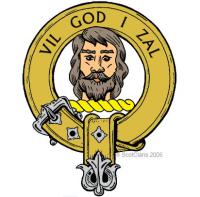
Clan Menzies
Mesnieres in Normandy was the original home of the Norman family whose name was transformed to Manners, the surname of the Dukes of Rutland. A branch of this family moved into Lothian and then gradually into the Highlands of Scotland, where they became known first as de Meyneris, and eventually as Menzies.
Robert de Meyneris appeared at the court of Alexander II, where he gained royal patronage and rose to the heights of Chamberlain of Scotland in 1249.The Menzies family became established within the earldom of Atholl, and Robert's son, Alexander Menzies, was granted property in the district of Strathtay. There are still many families of the name Menzies to be found in the area to this day. Alexander was also granted the property of Weem, though it took two centuries before the castle of Weem was built there.
The Menzies family achieved further successes by supporting Robert the Bruce - by the time of his death, the Menzies' possessions stretched from Aberfeldy almost as far as Loch Lomond.
Another branch of the clan boasted a governor of Orkney and Shetland.
In the sixteenth century, James IV granted a charter converting the Menzies' lands into a barony. By now the clan was gaelic speaking and the chief became known as "Am Mainnearach" meaning "The Menzies".
It was a member of the Menzies family, Colonel James Menzies, who was responsible for the introduction of the larch tree to Scotland, which now flourishes throughout the Highlands. Brought from the Tyrol in 1737, the original trees can still be seen in the grounds of the Duke of Atholl's residence.
Menzies Castle, the family seat of the clan, was used in World War II as a Polish army medical stores department, and was rescued from falling into decay by the Clan Menzies Society, who are now restoring the building.







